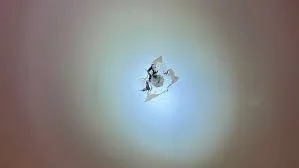A piece of abandoned space station (ISS) equipment unexpectedly re-entered Earth’s atmosphere on March 8, 2024, and smashed through the roof of a house in Naples, Florida. This occurrence highlights the growing concern over space debris. Fortunately, no one was hurt, but the incident serves as a reminder of the risks associated with orbital debris and the difficulties in mitigating it.
The ISS routinely disposed of 5,800 pounds of aged nickel-hydrogen batteries, which is where the debris in question came from. The abandoned hardware, which included a metal bracket holding the batteries in place, was supposed to burn up harmlessly as it descended through the atmosphere, according to NASA. A portion of the bracket, about 4 inches tall and 1.6 inches in diameter, did, however, survive re-entry and have an influence on the Florida residence due to an error in computation or an unanticipated circumstance.
Alejandro Otero, the homeowner, stated that he discovered the damaged object inside his home after receiving a tip from his son. Though fortunately no one was in the debris’s direct path, the incident nevertheless resulted in substantial damage. Space debris management and the possible effects of our growing space footprint have come back into focus as a result of this near miss.
A little portion of the discarded mass, usually less than 1%, can survive atmospheric friction and reach the Earth’s surface, even though controlled re-entries are the ideal way to dispose of spacecraft components. Since most debris ends up in remote locations like the ocean, there is often little risk involved. The Florida incident, however, shows that even tiny items, if they fall in populous regions, have the potential to cause harm or even property damage.
NASA has initiated a comprehensive inquiry to determine the root cause of the problem in response to the incident. Experts will examine the debris that has been recovered and reevaluate the calculations that were made to estimate its re-entry path. To identify the cause of the occurrence and stop it from happening again, this investigation is essential.
Beyond this particular incident, the crash in Florida serves as a reminder of the expanding problem of space debris. There are a growing number of objects orbiting Earth as a result of increased space activities by different countries and private enterprises. This expanding population of space junk is primarily made up of abandoned spacecraft, rocket stages, and collision debris.
Spacecraft that are in operation are seriously threatened by this junk. When small objects collide, they can cause catastrophic damage even at orbital velocities. The International Space Station (ISS) has recently needed to make a number of movements to avoid debris.
The growing issue of space debris is being addressed by investigating a number of remedies. Creating technologies for the deliberate removal of trash from orbit is one strategy. Another tactic is to build spaceship parts that have a higher chance of burning up entirely on re-entry. Furthermore, the development and implementation of successful debris mitigation strategies require international cooperation.
The Florida near-miss serves as a warning. Although space travel presents countless potential, it is imperative that we carefully handle the problem of space trash. We can guarantee future generations’ safe space exploration by funding research, putting preventative measures in place, and encouraging international cooperation.







